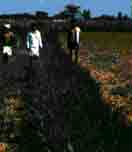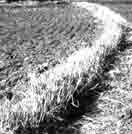

Vetiver Grass - Vetiveria zizanioides
A Photo Essay
Part 2 - The Hedge
To be functional as barrier against erosion, vetiver grass must be planted as a dense
hedge. Except where such hedges are used for boundary delineation, all hedges should be
planted on the contour. In this way erosion products, mainly in the form of soil sediment,
that are transported by rainfall runoff down the slope are deposited and spread out behind
the hedge barriers. These deposits gradually increase in height and volume to form natural
terraces behind the hedge row. One of the useful characteristics of vetiver is that it
will continue to grow whatever the depth of sediment deposits. The following photographs
show vetiver hedges growing under different conditions around the world.
These hedgerows are from southern India. The one on the left is on a farmer's field
at Gundalpet where Indian farmers have used vetiver hedges for hundreds of years. Note the
leaves of the hedge are cut every four to six weeks for fodder. The hedge on the right is
about two years old and is grown under rainfall conditions of about 700 mm annually.
These hedge rows are on commercial farms. On the left are hedge rows on steep sugar
lands in Natal, South Africa, and on the right recently introduced hedgerows on the black
soils of the Darling Downs of Queensland, Australia. The former is used to reduce soil
erosion due to high velocity down hill flows of runoff, the latter is to reduce the impact
of flooding on these relatively flat farm lands.
These hedgerows are on small farms in: Ethiopia (above left) at 1500 meters a.s.l.
with coffee , Malawi (above right) with fruit trees, and Fiji (bottom) with sugar. In the
latter scene the hedges have been established for at least 30 years and distinct natural
terracing and land slope change has occurred.
Vetiver is found in Florida ( above left), here used for landscaping to enhance the
looks of a bridge,in Panama ( above right) as a farm hedge, in Guatemala (bottom) to
protect a road in a coffee estate
Vetiver is used in many countries of South East Asia, such as in the scenes above.
On Java (Indonesia) to protect vegetable lands on steep hillsides, and in Malaysia on a
rubber estate.
This final photograph is a cross section of a vetiver grass hedge in which can be
clearly seen the build up of sediment behind the hedge and above the original top soil
(dark humic layer).